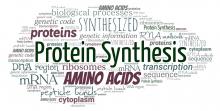BACKGROUND
Cell-free protein synthesis involves the production of proteins in the absence of living cells by using a mixture of extracted machinery and molecular components from chassis organisms (e.g. E. coli). It is an emerging format for the rapid testing of protein properties and function (e.g. functional screening). It is also advantageous in situations where protein synthesis is enhanced by conditions (e.g. pH, redox potentials, temperatures) outside the normal range of cells, and also enables on demand co-and-post-translational modifications of proteins, incorporation of non-natural amino acids, selective and site-specific labelling, and production of toxic or difficult proteins. A key limitation though is the dependence of cell-free systems on plasmid DNA templates which are both timely (>3 days) and costly to generate, reducing the throughput of protein production and slowing the research and development process. A linear DNA template on the other hand can be cheaply and quickly (3 hrs) generated but is susceptible to rapid degradation by exonucleases in cell-free reactions. If this degradation rate could be reduced or eliminated to make cell-free systems compatible with linear DNA templates, the throughput of cell-free protein synthesis could be dramatically increased and production costs sharply reduced.
TECHNOLOGY
Inventors at the University of Toronto have developed a high-efficiency method for protection of linear DNA for cell-free protein synthesis. It uses a protecting protein which tightly binds to a particular 23-bp DNA sequence guide, the latter positioned flanking the gene of interest (Fig. 1). This inhibits exonucleolytic degradation of linear DNA templates and allows for protein yields at least as high as plasmid-based expression.
Figure 1. Protein-based protection of linear DNA. In the absence of the protecting protein and terminal DNA guide sites, the helicase-exonucleases present in cell-free lysates can degrade the double-stranded DNA from either end. In the presence of terminal DNA (guide) sites, the protein will firmly bind to DNA ends and blocks the progress of helicase-exonucleases, thus protecting the linear DNA.
COMPETITIVE ADVANTAGE
- Affords gene expression from linear DNA templates at the same or even higher levels than a circular DNA template (Fig 2), yet it is faster (~20x) and cost-competitive
- Robust and orthogonal protection strategy applicable to different chassis organism lysates (e.g. V. natriegens), unlike the gold standard GamS protection system
- Practical and convenient; requires minimal manipulations to the cell-free reactions or the linear DNA templates
- Ability for performance upgrade by a simple increase of terminal “guide” sites (from one to two or more in tandem)
APPLICATIONS
- Commercialization of cell-free protein production is a rapidly growing market and already has established players using the system for the production of therapeutics. The market leader is Sutro Biosciences who operates cell-free reactions at scales as large as 1000 L for the production of biologics.
- Potential for widespread use in the fields of cell-free synthetic biology, proteomics, protein engineering, diagnostics, and other aspects of biotechnology.
INTELLECTUAL PROPERTY STATUS
- Provisional patent filing
PROJECT STATUS
- Proof-of-principle studies using lysates from E. coli and V. natriegens demonstrate high-protection efficiency of the Protein-DNA system (i.e. with a comparable degradation-resistant profile to plasmids) (Fig 2) and potential applicability across many chassis organism lysates including eukaryotic lysates.
Figure 2. Proof-of-principle studies showing the comparable protection efficiency, as measured by protein expression, of our protecting protein (PP) to the gold standard GamS system in E. coli with vastly superior performance observed in V. natriegens.





